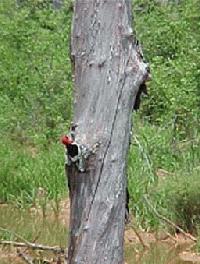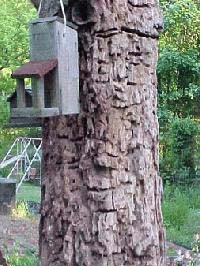Source(s): Stephen D Pettis
Create suitable habitats for birds through landscaping. Gardeners can provide birds with the things they need to survive and birds can provide gardeners with hours of enjoyment in the backyard.


Planning a landscape that is suitable for birds is easy. Sketch the existing landscape, making note of all structures, plantings and topographical features. Choose areas to plant trees and shrubs that birds can utilize. Annuals and perennials that flower throughout the season attract insects that birds may feed on. Standing dead trees will provide habitats for birds such as woodpeckers.
After making plant choices that provide food, shelter and cover for birds, artificial features should be considered. Water sources such as birdbaths, fountains and ponds may be added to landscapes to attract birds. The features should be in the open away from any place cats and other predators can hide. Rocks and water plants add to a water feature’s attractiveness to birds as well as keeping the water fresh. Man made birdhouses can be installed. These should be placed in sheltered spots near a shrub or tree. Finally, birdfeeders can be added. All bird feeders should be placed in the open near some sort of cover. Baffles and guards should be placed on mounting poles of both birdfeeders and houses to prevent predation.
Trees and Shrubs for Birds |
|||
|
Plant |
Plant type |
Feature |
Birds attracted |
|
Oak |
Tree |
Excellent nesting |
Blue jays, sparrows, acorn woodpeckers |
|
Pine |
Tree |
Excellent nesting |
Robins, purple finches, mourning doves, warblers, sparrows |
|
Holly |
Large shrub |
Shelter |
Towhees, thrashers, mockingbirds |
|
Elderberry |
Large shrub |
Summer fruit |
Warblers, grosbeaks, goldfinches |
|
Dogwood |
Small tree |
Nesting, late summer fruit |
Bell’s vireos, summer tanagers |
|
American Beautyberry |
Shrub |
Late summer fruit |
Many birds |
|
Native roses |
Shrub |
Nesting, cover |
Many birds |
|
Eastern Red Cedar |
Tree |
Nesting, winter fruit |
Sparrows, robins, mock-ingbirds, many others |
|
Winterberry Dec. Holly |
Small shrub |
Late winter fruit |
Robins, blackbirds, cedar waxwings |
Attracting birds to one’s yard by birdscaping can be rewarding. Birds are not only beautiful and fun to watch, but also provide control of adult insects, grubs, and caterpillars. By improving suburban and urban landscapes, people can help replace bird habitat that has been reduced or destroyed by development. To learn more about attracting birds to your landscape, contact the Gwinnett County Extension Service at (678) 377-4010.
Feeders |
|
| Squirrel proof feeders | Spinners, flippers, trapdoors prevent pesky squirrels from robbing feeders |
| Platform feeders | Feeds many birds at once |
| Tube feeders | Plastic tube with staggered holes |
| Hummingbird feeders | Glass feeders filled with sugar water (1 part sugar, 4 parts water; no red dye needed; boil and cool before use) |
| Suet feeders | Wire suspended suet cake. Birds often hang upside down to feed. |
| Thistle feeders | Narrow tube feeders |
| Peanut feeders | Attracts woodpeckers |
| Window feeders | Suction cups attach feeder to window |
.
Resource(s):
Reviewer(s):
- K. Lynn Davis, CEA- Turner County. The University of Georgia College of Agricultural and Environmental Sciences.
- Brandy Wilkes, CEA- Cook County. The University of Georgia College of Agricultural and Environmental Sciences.
Center Publication Number: 105
- Herbicide Damaged Plants - September 24, 2013
- IPM in the Garden - September 24, 2013
- Leylands Get Really Big - September 24, 2013